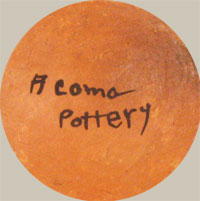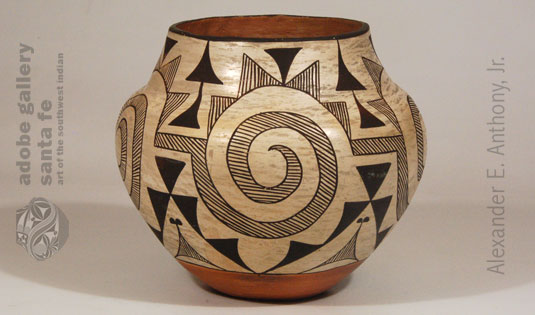Nineteen Thirties Acoma Black on White Tularosa Design Jar [SOLD]
+ Add to my watchlist Forward to Friend
- Category: Historic
- Origin: Acoma Pueblo, Haak’u
- Medium: clay, pigment
- Size: 7-⅞” height x 8-⅞” diameter
- Item # C4068S SOLD
Although this is a 20th century Acoma Pueblo jar, it is decorated with what has been designated as “Tularosa Black-on-white.” Acoma potters were impressed with prehistoric pottery designs and began reintroducing them in the early twentieth century.
Typology names used on pottery found in the Southwest were established at a conference of archaeologists held at Gila Pueblo in Arizona in 1930. “There, scholars worked out a system of nomenclature for classifying the ceramic types they were finding in the Southwest. The system enabled them to classify broken pieces of pottery, or sherds, and whole vessels. Based on designations for various kinds of prehistoric pottery, the system is used for historic pottery as well.
“Following this method, each distinctive type of pottery receives a two-part descriptive name. The first part of the name—such as Tularosa, Hawikuh, or Ako—is often derived from the geographical location where the type was identified (the ‘type site’). Alternatively, it may be taken more loosely from the local native language or may be an anglicization of a place-name. The second part relates to some technical attribute associated with the style of construction or painting: corrugated, black-on-white; black-on-red, polychrome, and so on.” Dillingham 1992:27
An example of such a type name is Tularosa Black-on-white as identified in this use by an Acoma potter who chose to decorate her jar with a Tularosa Black-on-white design. Technically, the jar is referred to as Polychrome because of the red underbody, but the design is Black-on-white.
The justification for Acoma potters using Tularosa designs is a test trench dug at Acoma that revealed small amounts of pottery dating between A.D.1100 and 1300, among which were Tularosa Black-on-white. If these existed at Acoma in circa A.D.1200, then the use of such designs was quite acceptable to potters of the twentieth century. There was no one to object to their reintroduction by modern potters.
 Acoma potters were inspired by designs used a thousand years ago, but they did not copy them but used them as inspiration for their own design creations. This jar is more open in design than Tularosa potters produced. The swirl design would have been larger and thicker on a Tularosa jar, leaving less white background visible. The execution of the design was expertly carried out. Each black line and each black triangle was applied with precision.
Acoma potters were inspired by designs used a thousand years ago, but they did not copy them but used them as inspiration for their own design creations. This jar is more open in design than Tularosa potters produced. The swirl design would have been larger and thicker on a Tularosa jar, leaving less white background visible. The execution of the design was expertly carried out. Each black line and each black triangle was applied with precision.
The jar is signed on the underside Acoma Pottery. It is estimated to be circa 1930s.
Condition: this Nineteen Thirties Acoma Black on White Tularosa Design Jar is in very good condition
Provenance: from a family from Colorado
Reference: Dillingham, Rick. Acoma & Laguna Pottery, School of American Research Press, Santa Fe. 1992

- Category: Historic
- Origin: Acoma Pueblo, Haak’u
- Medium: clay, pigment
- Size: 7-⅞” height x 8-⅞” diameter
- Item # C4068S SOLD



